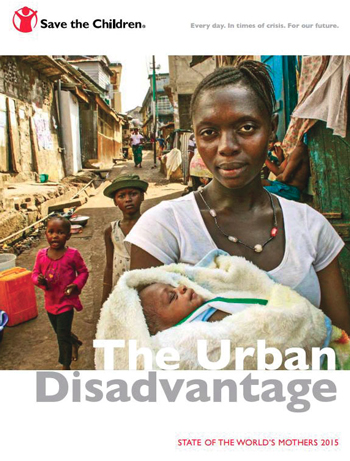Babies living and dying based on zip codes
By Nisa Islam Muhammad -Staff Writer- | Last updated: May 12, 2015 - 8:27:58 AMWhat's your opinion on this article?

|
These were the findings released May 4 in Save the Children’s new report “State of the World’s Mothers 2015: The Urban Disadvantage.”
“Our new report reveals a devastating child survival divide between the haves and have-nots, telling a tale of two cities among urban communities around the world, including the United States,” said Carolyn Miles, president and CEO of Save the Children. “For babies born in the big city, it’s survival of the richest.”
Save the Children’s report reveals a harrowing reality for urban moms and their children living in poverty throughout the developing world. In two-thirds of countries surveyed, the poorest urban children are at least twice as likely to die as the richest urban children.
• The disparity in child survival rates between the rich and poor in urban areas has widened over roughly the past two decades in nearly half of the 40 developing nations surveyed.
• According to the report, in 60 percent of developing nations surveyed, city children living in poverty are more likely to die than those living in rural areas.
• The 10 countries with the greatest survival divide between wealthy and poor urban children are: Bangladesh, Cambodia, Ghana, Kenya, India, Madagascar, Nigeria, Peru, Rwanda and Vietnam. In these countries, children from poor families are 3 to 5 times as likely to die as children from wealthy families.
• That may seem understandable because of the extensive poverty in those countries. What may not be understandable is the health gap between the rich and poor is just as prevalent in big cities in some of the world’s wealthiest nations.
• The U.S. capital has the distinction of having the widest divide between the health of rich and poor children. Washington, D.C. placed last in a ranking of child survival among 25 capital cities in the wealthiest countries. Among shameful findings in America’s capital:
• Save the Children found in 2012 the infant mortality rate in D.C.’s poorest neighborhood, Ward 8, was more than 10 times higher than the rate in D.C.’s wealthiest community, Ward 3.
• In 2012 the infant mortality rate in Ward 8 was 14.9 deaths per 1,000 live births. In Ward 3, the infant death rate was 1.2 deaths per 1,000 live births.
“Our local government recognizes the importance of giving all babies a healthy start in life by ensuring that women of reproductive age achieve optimal health, before and during pregnancy,” said Dr. Djinge Lindsay, deputy director of Programs for the D.C. Department of Health.
“That’s why we are partnering across sectors in the District, like education, housing and employment, to make sure all of our women and families have equitable access to preventive care and community resources that support improved health status and healthy behaviors and ultimately prevent infant deaths.”
According to the report, over the past 15 years, Washington, D.C. has cut its overall infant mortality rate by more than half, reducing it from 15 to 6.6 deaths per 1,000 births, according to preliminary figures for 2013. Nevertheless, babies born in our nation’s capital are dying at a higher rate than the U.S. average of 6.1 deaths per 1,000 live births. In addition, infant death rates in the city’s poorest wards, especially Ward 8, have remained much higher than the city-wide average in recent years. Ward 8 is also a predominantly Black ward in once majority Black city that has seen major changes in its racial population.
“It’s very sad that sometimes young women don’t get early prenatal care, sometimes they don’t show up for care until they are six or seven months pregnant. Some don’t get any care at all,” Holly Muhammad, Ward 8 advisory neighborhood commissioner told The Final Call.
“Since the women are not coming in, my suggestion is that we should be going to them and that’s not being done. They receive other services and someone in the system knows they are pregnant. Managed care organizations are working to get them in but they’re not coming. We have to meet people where they are. We have to go into their homes and encourage them to get prenatal care, and give them healthy eating tips.”
• The bottom of the list includes Vienna (Austria), Bern, (Switzerland), Warsaw (Poland) and Athens (Greece).
• According to the report, babies are most likely to survive in Prague (Czech Republic), Stockholm (Sweden), Oslo (Norway), Tokyo (Japan) and Lisbon (Portugal).
The good news is that a number of cities are making significant gains for the poorest children, including Addis Ababa (Ethiopia); Cairo (Egypt), Guatemala City (Guatemala), Kampala (Uganda); Manila (Philippines) and Phnom Penh (Cambodia).
These cities are working to increase access to basic maternal, newborn, and child services; raise health awareness; and make care more affordable and accessible to the poorest urban families.
“We need to concentrate our efforts to save the lives of mothers, children and newborns who are most in need,” said Dr. Valsangkar. “Eliminating the urban disadvantage should be a priority for our leaders as they set new long-term goals to end preventable deaths of mothers, children and newborns around the world.”
INSIDE STORIES AND REVIEWS
-
-
About Harriett ... and the Negro Hollywood Road Show
By Rabiah Muhammad, Guest Columnist » Full Story -
Skepticism greets Jay-Z, NFL talk of inspiring change
By Bryan 18X Crawford and Richard B. Muhammad The Final Call Newspaper @TheFinalCall » Full Story -
The painful problem of Black girls and suicide
By Charlene Muhammad -National Correspondent- » Full Story -
Exploitation of Innocence - Report: Perceptions, policies hurting Black girls
By Charlene Muhammad -National Correspondent- » Full Story -
Big Ballin: Big ideas fuel a father’s Big Baller Brand and brash business sense
By Bryan Crawford -Contributing Writer- » Full Story






 Click Here Stay Connected!
Click Here Stay Connected!








